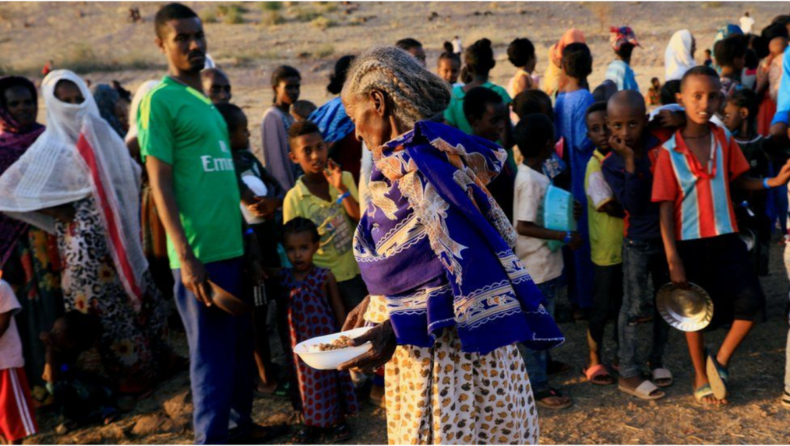Ethiopia has been burning in gripping civil unrest since 2015. The internal conflict between the ethnic groups of the nation has ravaged the country into a humanitarian crisis.
Highlights:
- Mass killings and violence were reported in Ethiopia.
- The Tigray genocide has resulted in death and displacement.
- Starvation used as a weapon of war – Alex De Wall.
Ethiopia is facing civil unrest due to the ethnic conflict between the Ethiopian Government and the Tigray People’s Liberation Front(TLPF). The nation has been in a constant state of flux which has resulted in a grave humanitarian crisis. The conflict between the Abiy Ahmed-led Ethiopian government and the TLPF has spiraled the region into a grave humanitarian crisis.
The beginning of the Ethiopian conflict:
An empire ruled Ethiopia from the thirteenth century up until 1974. Various ethnicities within the empire were treated as second or third classes. The empire was built on conquered nations and Eritrea was one among them. Eventually, the empire was replaced by a communist dictatorship led by Colonel Mengistu who ruled from 1974 to 1991. The brutal government killed untold numbers of Ethiopians and political opponents. According to a report, at least 30,000 people were killed during this period.
The atrocities of the Mengistu government led to civil war, and a number of militia groups formed around the country. The Eritrean People’s Liberation Front (EPLF) and the Tigray People’s Liberation Front(TLPF) were two of the strongest militias formed in response. Civil war raged for decades, and in 1991, Mengistu stepped down from power.
Eritrea declared itself independent in 1993, and the TPLF took control of Ethiopia. An alliance with other political parties of the nation, the EPRDF(Ethiopian People’s Revolutionary Democratic Front) was formed and ruled for almost 30 years. However, the TLPF played an authoritarian role in the coalition. The Tigrayans contributed to 6% of the population, but the TPLF played a dominant and repressive hand in the ally.
Although the country made marginal progress during the rule of EPRDF, it continued to restrict journalism, jailed political opponents, and elections were accused of being rigged. In addition, a war against Eritrea began in 1998 and continued for decades, deteriorating Ethiopia’s condition even deeper. The failure of the EPRDF and the TLPF triggered a series of protests and frustrations from 2015 to 2017, forcing the prime minister to step down.
The rise of Abiy Ahmed:
The TPLF named Abiy Ahmed as the prime minister in 2018 even though he was not a Tigrayan. Abiy seemed dynamic and spoke of peace and reconciliation. The TPLF believed Abiy would help them maintain their influence in the country. However, the new prime minister removed corrupt TPLF leaders from the party, released jailed political opponents, and lifted the restrictions on journalists. Abiy promised an Ethiopia that is second to none in its freedom of expression.
Abiy quickly rose to fame after creating a new political party named the prosperity party. The TPLF was invited but refused to join the new party. In addition, he reached out to Eritrea and ended the decade-long war for which he won the Nobel Peace Prize. However, tensions were building internally against the government, and the conflicts between the ethnic groups were on the rise. Abiy responded to the protest movements by restricting activists and journalists, locking up political opponents, and tens of thousands of protestors were arrested.
Like many other countries, Ethiopia postponed the elections due to COVID in 2020. The political opponents raised an issue and accused Abiy of using the pandemic to stay in power. The Tigrayans defied the government and held their elections. Irked by this move, Abiy mobilized the military and issued a statement that the Tigrayans had attacked a military base and the government would be forced to retaliate using military power. Thus, a war between the two groups raged resulting in death, diaspora, and a hunger crisis.
The Tigray Cleansing:
The region of Tigray was cut off from the mainland. Journalists were not allowed to report. Internet and cell phone access were cut-off. An estimate of 60,000 people fled across the border to Sudan. Two million people are said to be internally displaced and unable to get out. As the friction between the military and the militias intensified, a widespread massacre of civilians and sexual violence were reported in Northern Ethiopia. People went missing, and children were killed. As per Ghent University, Tigray has seen over 500,000 civilian deaths.
Farmers are prevented from plowing their lands as the region faces extreme hunger. Food shortages have left the Tigrayans vulnerable to catastrophic starvation. Food aid and essential services are stopped from entering the Tigrayan region. Bridges connecting Tigray to other regions are demolished. However, the Ethiopian government denies all the accusations. Alex De Wall, executive director of the World Peace Foundation says, “It’s a 100 percent man-made famine. Starvation is used as a weapon of war to eliminate.”
Approximately 5.7 million people in Tigray are affected by the crisis. The United Nations estimates that 4.5 million are “in need”. As starvation grapples, the Ethiopians await help and hope for a solution at the end of this civil war.













